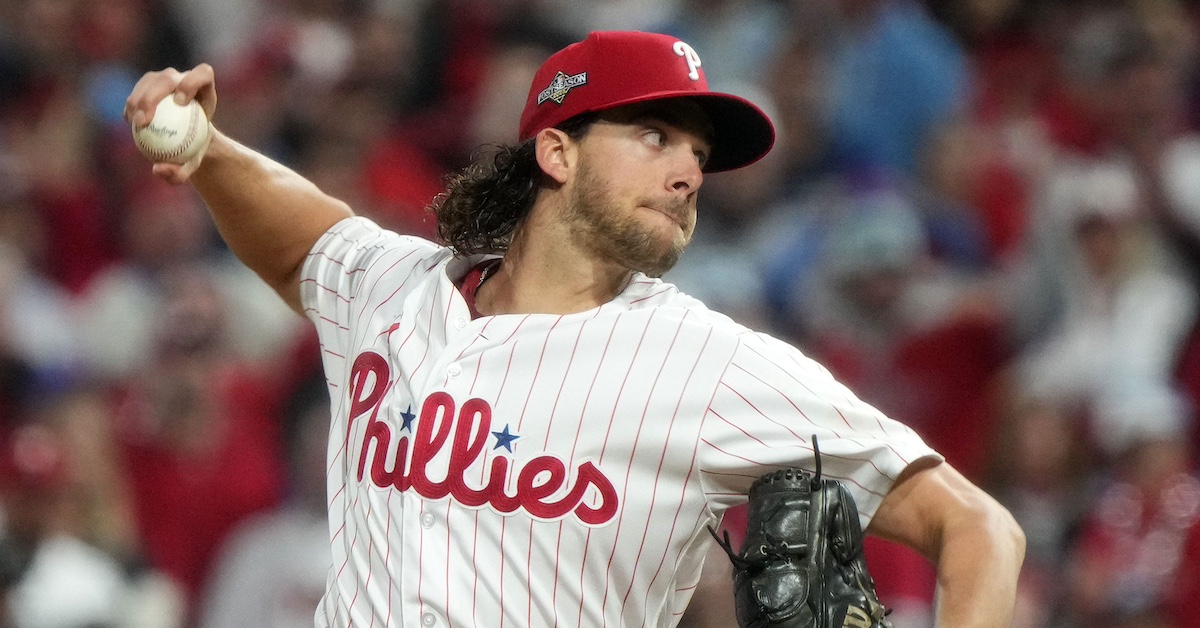In the First Big Signing of the Offseason, the Phillies Bring Back Aaron Nola

Philly baseball fans didn’t even have to wait until the turkeys were in the oven for the first major Phillies news of the offseason, as Bob Nightengale and Jeff Passan reported Sunday that the team has brought back Aaron Nola on a seven year, $172 million contract that will keep their no. 2 starter in town until the end of the 2030 season.
The Phillies have enjoyed significant postseason success recently, with a trip to the World Series in 2022 and an NLCS run that almost resulted in a return to the Fall Classic this year. That being said, getting to the playoffs via a Wild Card spot is always going to be a more uncertain path than winning the division, and in each of the last two seasons, the Phils finished well behind the division leader. For a team with an aging core that’s in win-now mode, the goal is to do better, and it would be hard — and expensive — to improve the team from 2023 without keeping Nola in the fold. Nola, the team’s first-round pick back in 2014, won’t come cheaply at $172 million. From a pure value standpoint, ZiPS isn’t overly excited about that figure:
| Year | W | L | ERA | FIP | G | GS | IP | H | ER | HR | BB | SO | ERA+ | WAR |
|---|---|---|---|---|---|---|---|---|---|---|---|---|---|---|
| 2024 | 12 | 8 | 3.84 | 3.37 | 30 | 30 | 180.3 | 164 | 77 | 22 | 36 | 195 | 113 | 3.4 |
| 2025 | 10 | 9 | 4.00 | 3.50 | 28 | 28 | 168.7 | 157 | 75 | 21 | 34 | 178 | 109 | 3.0 |
| 2026 | 9 | 9 | 4.22 | 3.70 | 26 | 26 | 158.0 | 152 | 74 | 21 | 33 | 161 | 103 | 2.4 |
| 2027 | 8 | 9 | 4.44 | 3.91 | 26 | 26 | 148.0 | 149 | 73 | 21 | 32 | 146 | 98 | 2.0 |
| 2028 | 8 | 8 | 4.75 | 4.16 | 24 | 24 | 142.0 | 148 | 75 | 22 | 32 | 135 | 92 | 1.5 |
| 2029 | 6 | 9 | 5.07 | 4.47 | 21 | 21 | 124.3 | 137 | 70 | 21 | 31 | 114 | 86 | 0.9 |
| 2030 | 5 | 8 | 5.37 | 4.68 | 18 | 18 | 107.3 | 122 | 64 | 19 | 28 | 96 | 81 | 0.5 |
But if any team is justified in paying more than the projection suggests for Nola, it’s the Phillies, given that they’re a wealthy team smack dab in the win range where additional wins are the most valuable.
This projection is a big step down from Nola’s forecast before last season, when ZiPS would have suggested a seven-year, $158 million extension, significantly closer to his actual contract figure. Problem is, Nola did have a relative down season, well off his 2020-22 averages, and that makes him riskier when considering a big deal. While Nola will probably allow fewer home runs in 2024, batters did hit him more successfully than in 2022. With his exit velocity and hard-hit numbers going up a bit, it isn’t all simple home run volatility at play. Losing 20-25% of your strikeout rate is a worrying sign for an older pitcher as well. That being said, it’s a still a reasonable start to the offseason for the Phillies, who hopefully won’t be content to just keep the current team intact.
My colleague Ben Clemens will be back tomorrow with more on the Nola signing.
Dan Szymborski is a senior writer for FanGraphs and the developer of the ZiPS projection system. He was a writer for ESPN.com from 2010-2018, a regular guest on a number of radio shows and podcasts, and a voting BBWAA member. He also maintains a terrible Twitter account at @DSzymborski.

Thanks so much for getting this out quick. As a Phillies fan, I think I would have preferred a higher AAV for fewer years from someone like Snell, but they really needed Nola to come back.
Could snell be had at a higher aav for less years? I don’t think he’s getting a substantially smaller guarantee. So unless we’re talking exactly the same total guarantee at fewer years, then I don’t think that alternative scenario was a real option.
I don’t know what Snell could be had for, but “total guarantee at fewer years” (what you said) is the same thing as “higher AAV for fewer years” (what I said). He could get 5/150 or something like that. You might not agree that’s a better value, but it certainly seems like a real option.
Why would you want him for the same money on fewer years? All that does is make your luxury tax payment higher. If you only think he’s gonna be good for 5 years, you can still sign him for 7 and cut him 6 years in if you need to. Same result and you spread your luxury tax out.
Extra years are also important if you think the player will miss upwards of a season and a half at the drop of a hat, which you should think for every pitcher.